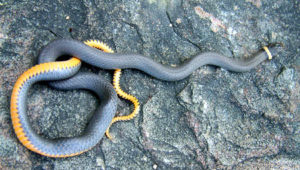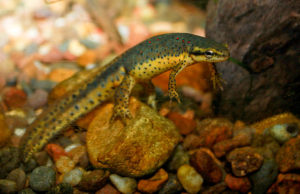. . . whenever it is a damp, drizzly November in my soul . . . Moby Dick by Herman Melville
I just turned 75 a few weeks ago. Not sure I like the sound of that. A well-known proverb suggests that we should not regret growing older. It is a privilege denied to many. I try to keep this in mind when I begin to feel a little too sorry for myself. In spite of aching joints, inflexibility, an alarming increase in girth, and the dozen other glitches associated with aging; I prompt myself to recall that I have, after all, gotten to start another orbit around our nearest star.
There is another, even better way in which I seek solace when the burden of gloominess threatens to engulf me. Through some miracle of good fortune or good planning (thanks to an astute spouse), I now find myself in possession of fifty acres of densely forested land. I say possession but that seems a presumptuous way to put it. The bedrock beneath my third of a homestead is composed of sediments laid down during the Pennsylvanian Period. This makes such stone about 300 million years old. I’ve “owned” it for 0.00000004 (four hundred-millionths) of that time; not long enough to really talk about possessing anything I’d say. But for now, I can pretend it is mine and wander freely over it. Such roving is a fine way to put aside thoughts of infirmities both real and imagined, feelings of world-weariness, worry. Traipsing through the woods makes for an easy transition into mindfulness, gratefulness, blissfulness. Negative emotions and musings seem to drift away when I engage in heedful contact with the natural world. I bet it could do the same for you.
Walking today, I passed a big chunk of Busseron sandstone lying on the surface. It must have weighed four or five tons at least. The face of the stone was imprinted with fossil crinoids. Around here folks call them “Indian beads”. Crinoids are relatives of starfish and sea anemones and live only in marine waters. And so I am reminded that the ground I walk upon was once covered by the shallow waters of a vast inland arm of the sea. Many of the denizens of this past water world would be familiar to me. Just as today, the seas were inhabited by corals, clams, squids, sharks and bony fishes. Some groups which flourished during that time, such as the clam-like brachiopods, have declined in diversity. Others, like trilobites and fusulinids, are gone entirely and are now known only from their fossil remains.
At other times during the Carboniferous Age, the land here was clothed in dense forests of cycads, tree ferns, giant horsetails, massive club mosses, and conifer-like Cordaites. I try to imagine, should someone grant me the temporary use of their time machine, how strange it would feel to rove this ancient world. Nary an oak, hickory, or other flowering plant would there be to encounter. Likewise this world was yet without frogs, birds or mammals. It was a realm so primordial that millions of more years must elapse before even the dinosaurs would make their way onto the stage. How eerily quiet it must have been! Granted, insects were already well established and included the ancestors of grasshoppers and crickets. They must have added their mixed choruses of clicks, buzzes, and chirps. Perhaps I would have heard the faint rasping of innumerable tiny legs as spiders, millipedes, and centipedes scuttled over the surface. They arrived plenty early in earth’s geologic history. But still, my mind struggles to imagine a world without bird song, the trill of courting frogs, or the territorial bugling of an elk.
The remains of these quiet forests eventually became the coal beds which rest beneath the surface here. Today the land I have strolled upon shows evidence of massive disturbance. Removal of this coal some seventy years ago has left my land with a topography that resembles a Brobdingnagian plowed field. Ridge after parallel ridge and their intervening valleys march across the landscape. In the zeal to reach the valuable coal beneath me, the land was turned upside down. Rich humus and soil, once on the surface, came to be covered by many feet of fractured sandstone and shale rendered into pieces by explosive ammonium nitrate. Even after all these decades, this land would make a fine rock farm. But, lest you picture a terrain despoiled and desolate, consider this.
Nature can heal itself. With a little help from us, She can do it even faster. Mined long before today’s more enlightened restoration laws were enacted, my land was once a pitiful, barren moon-scape of shattered overburden. Little was done to help this land recover save for the scattered planting of trees over its surface. And now today, lo and behold, I walk through a forest. White oak, yellow poplar, sycamore, redbud and dogwood; all are here. Interspersed among them are white pines of admirable size.
When the land was excavated, every resident chipmunk, fox squirrel, white-tailed deer, and pileated woodpecker was evicted. Gone was each gray tree frog, morel, fern, and red-backed salamander. No white-footed mice scurried through leaf litter. No barred owl sat in stealthy watchfulness of their rodent shenanigans. Not a spring beauty, toothwort, or mayapple remained to greet the spring. Now, all of these have reappeared. Granted some unpleasant guests have hitchhiked in too. I wage a constant battle against invasive autumn olive, bush honeysuckle, and garlic mustard. But overall, like the reincarnation of a departed ancestor, the despoiled ground has given rise to a good representation of what a Midwestern mixed forest should be.
And the woodland’s inhabitants are back too! My walks are enlivened by the calls of barred owls, red-shouldered hawks, and pileated woodpeckers. Prothonotary warblers, Carolina wrens, and wood thrushes enthusiastically announce their residence here. Wild turkeys gobble, white-tailed deer stealthily patrol the trails, gray squirrels bark, and raccoons leave their little hand-like prints in the muddy lake margins. They’ve all returned! It really is quite wonderful and I never know for sure what a day’s hike might have to offer.
But there are two animals which seem, in my mind, particularly emblematic of the forest’s rebirth. Though somewhat common in my woodland, they exist unseen by all but the most diligent searchers. I nominate the ring-necked snake and the red-spotted (Eastern) newt as symbols of Nature’s amazing ability to recuperate from the savage blows we bestow upon Her.
 What a handsome little creature is the ring-necked snake. Small by serpent standards, they average around ten inches in total length. Their dorsal coloration is a dark, blackish gray with a bright yellow ring around their neck. While their back is somberly colored, much like the pieces of shale under which I often find them, their bellies are a flamboyant yellow or orange.
What a handsome little creature is the ring-necked snake. Small by serpent standards, they average around ten inches in total length. Their dorsal coloration is a dark, blackish gray with a bright yellow ring around their neck. While their back is somberly colored, much like the pieces of shale under which I often find them, their bellies are a flamboyant yellow or orange. 
Because of their small size and secretive habits, many people have never seen a ring-necked snake. This is in spite of the fact that they may be quite common in certain areas. In searching for these snakes, I often find red-backed salamanders furtively lurking under flat stones too. These amphibians are preyed upon by ring-necked snakes. Perhaps this is why the little ring-necks seem to be one of the more common snakes inhabiting my woodlands.
And here is one more reason I consider this little creature a fascinating find during one of my forest jaunts. Recent research has demonstrated that ring-necked snakes are venomous. While docile and harmless to humans, the secretions of their Duvernoy’s glands* are lethal to their smaller ![]() amphibian and reptilian prey**. If you aren’t familiar with snakes, it might also surprise you to learn that the ring-necked snake’s fangs are located not at the front of the mouth, but at the back. The enlarged rear-fang of a ring-necked snake is indicated in the accompanying photo (from O’Donnell et. al.)***
amphibian and reptilian prey**. If you aren’t familiar with snakes, it might also surprise you to learn that the ring-necked snake’s fangs are located not at the front of the mouth, but at the back. The enlarged rear-fang of a ring-necked snake is indicated in the accompanying photo (from O’Donnell et. al.)***
This winter these little jewels of the serpent world will den below the frost line. Come next spring, they will be emerging at about the same time I’ll be combing the forest for morels. Even while focused upon the fungi, you can bet I won’t be able to resist turning the occasional stone in hope of reacquainting myself with this petite emblem of Nature’s ability to persevere.
Looking for the red-spotted newt during by woodland ramblings requires a  different strategy. Not on the rock-strewn slopes must I search. Instead, it is the small lakes that fill some of the valleys I must investigate. Adult red-spotted newts are aquatic salamanders. Larval newts have gills just as other salamanders and frogs do. But as adults they have lungs. If I lie very quietly at the edge of one of the small ponds on my land, I may be rewarded by seeing a newt lazily float to the surface for a tiny breath of air. If I give myself away, it will very quickly make a U-turn and, with undulations of its oar-like tail, make a crash dive toward the bottom. Introducing oneself to a newt requires patience.
different strategy. Not on the rock-strewn slopes must I search. Instead, it is the small lakes that fill some of the valleys I must investigate. Adult red-spotted newts are aquatic salamanders. Larval newts have gills just as other salamanders and frogs do. But as adults they have lungs. If I lie very quietly at the edge of one of the small ponds on my land, I may be rewarded by seeing a newt lazily float to the surface for a tiny breath of air. If I give myself away, it will very quickly make a U-turn and, with undulations of its oar-like tail, make a crash dive toward the bottom. Introducing oneself to a newt requires patience.
What a fascinating life cycle this little vertebrate exhibits. Hatched from an egg deposited in the water, the little gilled larvae spends two or three weeks in this aquatic stage. It then transforms into a life-stage known as a red eft. In this form, the eft takes to the forest where it lurks beneath fallen logs and feeds on tiny terrestrial invertebrates such as springtails and mites. After three years or so of life on land, the eft returns to the water, further transforms and takes up residence as the adult red-spotted newt more familiar to us.
Like the ring-necked snake, the eft harbors a secret. This time a defensive one. Red eft skin secretes a toxin known as tetrodotoxin. This compound is also present in the skin of adults though in lower concentration.  Tetrodotoxin is one of the most deadly neurotoxins known. You might be familiar with it as the toxic ingredient in fugu, the Japanese puffer fish delicacy. Tetrodotoxin is found in the bite of the potentially deadly Pacific blue-ringed octopus as well. Who would have thought that our little Hoosier-dwelling newt had anything in common with two of the most notoriously venomous animals in the world?
Tetrodotoxin is one of the most deadly neurotoxins known. You might be familiar with it as the toxic ingredient in fugu, the Japanese puffer fish delicacy. Tetrodotoxin is found in the bite of the potentially deadly Pacific blue-ringed octopus as well. Who would have thought that our little Hoosier-dwelling newt had anything in common with two of the most notoriously venomous animals in the world?
And so these are some peeks into one of my favorite emotional coping mechanisms. When beleaguered by the stresses of modern life, when besieged by the imperfections of aging, when I need a little nudge to remember that I have been blessed with a life full of learning and adventure: to my forest retreat I must go. Walking quietly or just sitting in meditation, I am immersed in a world of incredible beauty and biocomplexity. There are trees needing identification, rocks to examine, life cycles to be considered, a million questions to be asked. How could there be time for brooding over difficulties, real or imagined?
_____________________________________
* Duvernoy’s gland – Wikipedia
**Ryan P. O’Donnell, Kevin Staniland, Robert T. Mason. 2007. Experimental evidence that oral secretions of northwestern ring-necked snakes (Diadophis punctatus occidentalis) are toxic to their prey. Toxicon. (810-815).
*** Among venomous snakes some have fixed, hollow fangs in the front of their mouths. Examples would be cobras and kraits. Others have hollow, front fangs which fold back when not in use. Rattlesnakes and true vipers (e.g. the Gaboon Viper) are examples. Rear-fanged snakes are known as opisthoglyphs. Opistho comes from the Greek word meaning behind. A glyph is an incised line refers to the grooved (rather than hollow) nature of opisthoglyphs fangs.
Photo Credits:
ring-necked snake close-up courtesy of www.estuarypartnership.org ring-necked snake by Linh Phu @ dnr.maryland.gov ring-necked snake skull from O’Donnell et. al. 2007 red-spotted newt by Brian Gratwicke at https//:creativecommons.orglicensesby2.0.jpg
